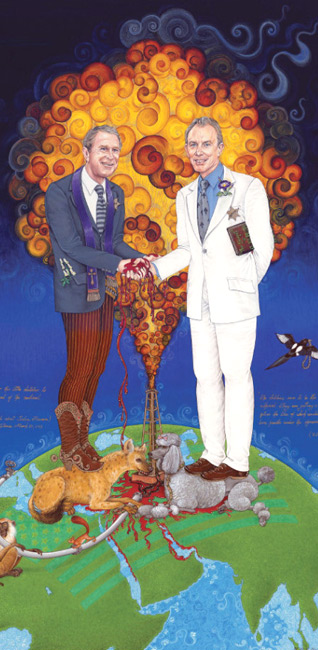Art
Ancient Traditions of Allegorical Miniature Painting Portray Contemporary Events:
Amrit & Rabindra Kaur Singh
MURRAY WHYTE
As a strategy for art-world success, the one employed by the Singh Twins would seem to have some holes.
“Narrative, decorative, figurative, non-European, small scale - all the things you’re not supposed to do in contemporary art,” they laugh. “So we just thought, ‘let’s put it all in one package and throw it out there.’ ”
And so, a couple of decades ago, they did.
But then a strange thing happened: They actually began succeeding.
From exhibitions at London’s Tate Gallery, the National Portrait Gallery and the Museum of London, to name just a few, the twins - Liverpudlian Brits, Sikh and bona fide art-world celebrities back home in the U.K. - have landed here, at the Peel Art Museum and Archive for their first retrospective in Canada.
Neither the location nor the timing are happenstance. The Twins - they identify only as a unit, not individually (“We don’t have a sense of individual ownership over the work,” they explain, allowing that it’s nonetheless “a bit of a stage name”) arrived here with 20-plus years of work in tow in time for Sikh Heritage Month, an annual celebration of Sikh culture in Canada.
Downtown Brampton, home to the Peel Museum, is a centrepoint of exactly that.
But for curator Tom Smart, the Twins offered the chance for a fresh approach. Gently iconoclastic, the Twins subvert not only contemporary art world expectations, but the perceptions of their own culture both from inside and out. Their medium is miniature paintings, a millennia-old technique of intricately rendered works unfolding epic parables with multiple entwined figures and scenarios.
“We come from a Sikh background, but we avoid calling ourselves Sikh artists to avoid being pigeonholed in the mainstream. We’ve always referred to ourselves as contemporary British artists, period,” they said recently, entertaining a casual walk-through of the just-opened show.
“And the main goal has been to put what has generally been seen as an ethnic style and bring it out into the mainstream and say it’s just as valid as any western style.”
In their version, an old form is given the breath of new life with a slate of contemporary concerns: The grinning figures of Tony Blair and George W. Bush shaking hands atop a globe smouldering beneath their feet, or Princess Diana seated atop an elephant, eulogized shortly after her death in the Twins’ satirical mode as a posthumous media darling after years of being a figure of scorn.
"Partners in Crime: Deception and Lies" (see image, above, right) makes clear how the Twins feel about the warfaring ways of former world leaders U.S. President George W. Bush and British Prime Minister Tony Blair. Both were seen as instrumental in the ongoing Iraq war.
Thus, the Twins use ancient traditions of allegorical miniature painting to portray contemporary events.
Hanging on a wall all its own, though, is perhaps the Twins’ most emblematic work: "1984", an intricate, powerful depiction on a black day in contemporary Indian history, when Prime Minister Indira Gandhi sent the Indian army into the Harmandir Sahib Complex (‘The Golden Temple’) in Amritsar, Punjab.
The operation was predicated on removing Jarnail Singh Bhindrawale, a Sikh leader who opposed Indian rule, from the temple complex, but the bloody attack on high holy ground for the Sikh population resulted in untold civilian deaths.
In the painting, the temple swims with carnage and the seep of crimson blood. Just as apparent as the chaos, though, is the Indian government’s unlawful bottling up of the incident in the public eye. The media is shown as gagged and blindfolded, reinforcing the painting’s title: 1984 was the date of the attack, but the Orwellian undertone of oppressive state control and propaganda, is just as intentional.
“We’re using an ancient language, but what we’re saying is relevant to everyone,” they said. “They’re universal social and political messages. That’s the key to maintaining tradition alongside modernity: Very often people try to separate the two - tradition/modernity, east/west. And our work is very much about countering that perception.”
The Singh Twins: A Retrospective continues at the Peel Art Museum and Archive ('PAMA') through June 12, 2016. Admission is free through April for Sikh Heritage Month.
[Courtesy: The Toronto Star. Edited for sikhchic.com]
April 6, 2016



